Fesenjan (Persian Pomegranate and Walnut Stew)
Jul 02, 2018, Updated Apr 16, 2024
This post may contain affiliate links.
Fesenjan is a classic Persian stew made with walnuts, pomegranate molasses and usually chicken. It’s sweet and sour with a rich nutty flavor thanks to the walnuts. The key to a delicious fesenjoon is to cook it low and slow for a few hours. Serve with Persian rice or pour it over tahdig and enjoy.
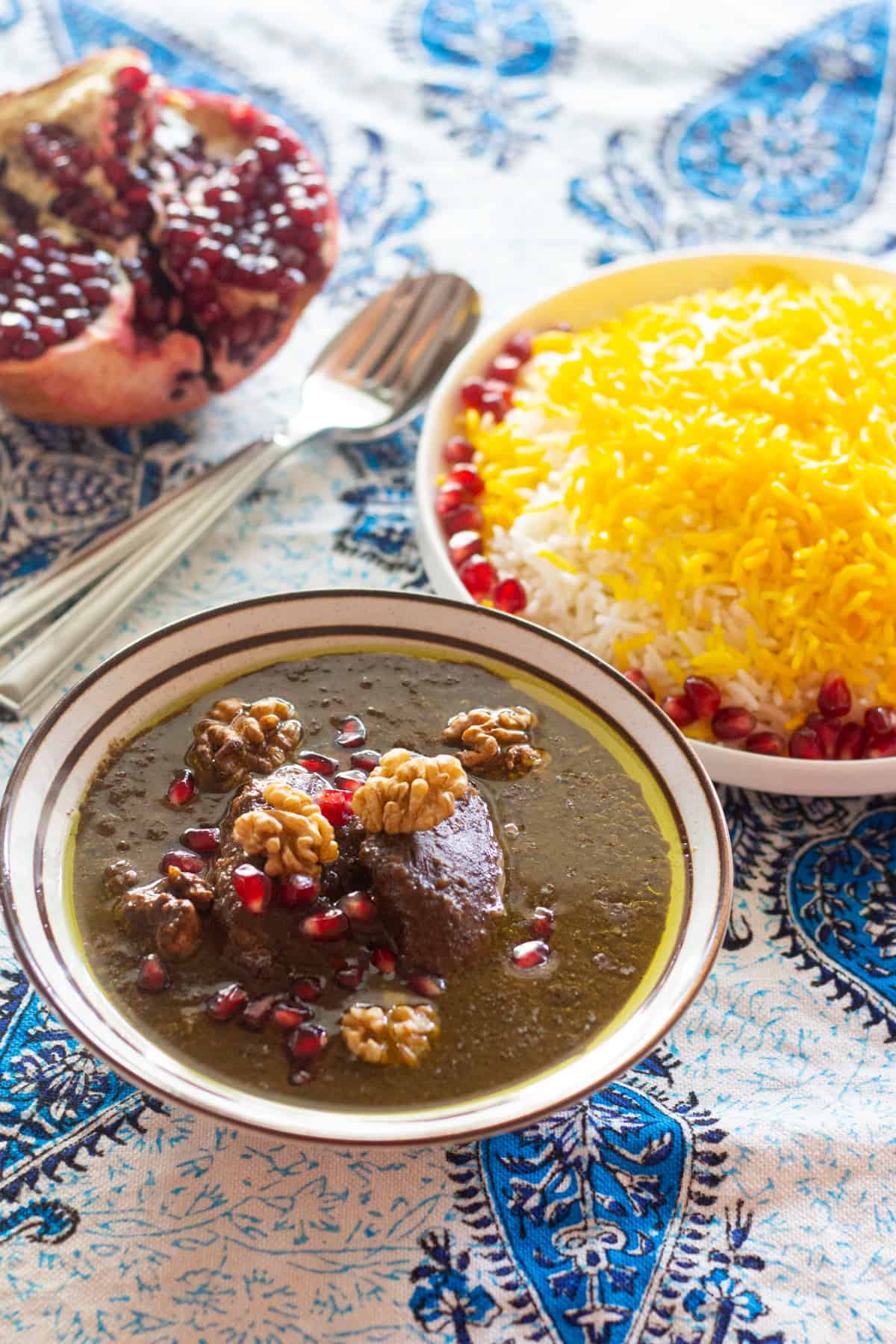
When it comes to Persian recipes, flavor is everything. Whether it’s a classic ghormeh sabzi, eggplant stew or the hearty Abgoosht – Persian Lamb, Potato, and Chickpea Stew, we always take the simplest of ingredients and, with a few tweaks here and there, turn them into a delectable and tasty dish. Today I’m going to show you how to make fesenjan or as some call it, fesenjoon, my all time favorite Persian dish made with ground walnuts, pomegranate molasses and chicken.
Table of Contents
- What Is Fesenjan
- What does Fesenjan taste like?
- What Is Fesenjan Made Of?
- How To Make Fesenjan
- Tips To Make The Best Fesenjan
- How To Serve Fesenjan
- Variations Of Fesenjan
- Storing The Leftovers And Reheating
- Frequently asked questions
- More Persian Recipes
- Fesenjan (Persian Pomegranate and Walnut Stew) Recipe
What Is Fesenjan
Fesenjan is one of the most popular Persian stews. It’s made with a protein such as chicken or duck cooked for hours in a rich walnut and pomegranate molasses sauce.
This Persian pomegranate and walnut stew originated in northern Iran, Gilan province to be exact, and has spread its way through cities all over Iran and made its way through the hearts of many around the world.
The combination of walnuts and pomegranates is well loved and commonly used in many dishes in the Northern region of Iran including marinades for kebabs such as kabab torsh, sauces, dips and appetizers such as zeytoon parvardeh (marinated olives).
I have a fond memory of fesenjan: when I was a kid, I used to refuse to eat this stew because of its color and my mom would never make an alternative meal because she knew it is one to love and cherish. Finally, one day she said “just have it once and see if you like it or not.” And with the first spoon in my mouth, I knew I was going to love this dish dearly for the rest of my life. The sour flavor coated in a subtle sweetness paired with the nutty flavor coming from the walnuts had me close my eyes and smile with all my heart.
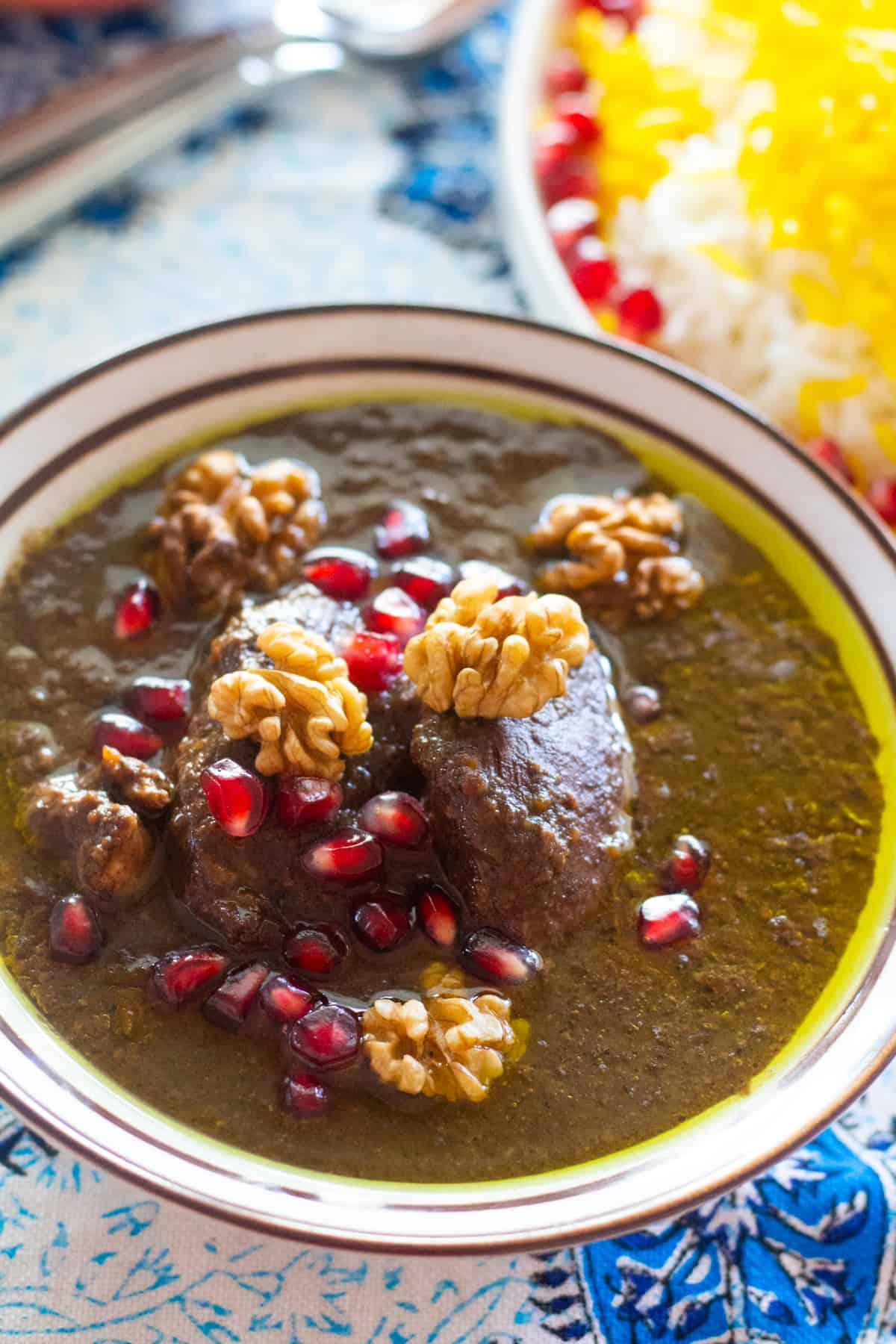
What does Fesenjan taste like?
Similar to Persian pomegranate chicken, the flavor of this stew varies from sour to sweet, depending on the pomegranate molasses and the addition of sugar. My family loves to prepare this dish sweet and sour, leaning more towards sourness. Thus, I usually don’t add sugar but some do. It really depends on how sweet you like it to be.
What Is Fesenjan Made Of?
- Onion: Like many other Persian stews, this recipe starts with sautéing onion in some oil until golden. This will be the base of the sauce.
- Chicken: Bone-in skinless chicken thighs work best for this recipe, but legs and breast work as well. I recommend using skinless chicken since it’s going to simmer in the sauce and the skin could get rubbery.
- Walnuts: I find grinding them in a food processor or a blender gives the best result. Blend the walnuts until you have a fine walnut meal.
- Pomegranate molasses: It’s a thick molasses made of pomegranate juice which gives this stew its rich dark brown color. You can find pomegranate molasses in Middle Eastern stores or online. Alternatively, you can make it at home using this pomegranate molasses recipe .
- Pumpkin or butternut squash: This is my little secret ingredient, an addition I learned from a friend’s mother who was born and raised in northern Iran. Walnuts are warm by nature, which means that after having a lot of them, your body feels warmer than usual. Adding mashed cooked pumpkin or butternut squash would balance the nature of fesenjan. It would also make the sauce creamy and thick.You can use canned pumpkin for this recipe.
- Spices: You only need turmeric, salt and pepper for this fesenjan recipe. Some suggest adding cinnamon or bloomed saffron, however, I don’t find it necessary since the walnuts and pomegranates are already rich in flavor.
How To Make Fesenjan
- Prepare the walnuts: Grind the walnuts finely in a food processor until there are no large pieces left, make sure not to overprocess them to avoid the walnuts releasing their oil. Keep in mind, the finer the walnuts, the thicker and smoother the sauce is going to be.
- Prepare the chicken: Season the chicken thighs with salt, pepper and turmeric on both sides. Heat some oil in a pot or a Dutch oven over medium high heat and sear the chicken for about 5 minutes on each side until golden. Transfer to a plate and set aside.
- Sauté the onions: Heat more oil in the same pot and sauté the onion until translucent and slightly golden.
- Add the walnuts: Add the ground walnuts to the sautéed onions and cook on medium until they start releasing their aroma, this would take about 15 minutes. Stir occasionally to avoid the walnuts burning.
- Cook the sauce: Pour in the water, turn the heat to medium high and bring it to a boil. Lower the heat to medium, cover and cook for 1 hour to 1 hour and 30 minutes so the walnuts release their oil. Stir occasionally to make sure the walnuts don’t stick to the pot.
- Add the pomegranate molasses and pumpkin: Add in the pomegranate molasses, cooked pumpkin, salt and pepper. Give it a good stir, cover and cook for another hour so the sauce starts to thicken. Make sure to stir the sauce every 15 minutes. The sauce might not look dark when you first start cooking, but with time, it will darken.
- Add the seared chicken: After 1 hour, add the seared chicken back to the stew and cook for another hour until the chicken is fully cooked and fall-off-the-bone tender. The dark brown pomegranate and walnut sauce will be a bit thick and there will be a thin layer of oil from the walnuts on the top.
- Taste and season if needed: Once the chicken is cooked, taste the sauce and add more salt or pomegranate molasses if needed. If the sauce is too sour for your taste, add a tablespoon of granulated sugar or brown sugar.
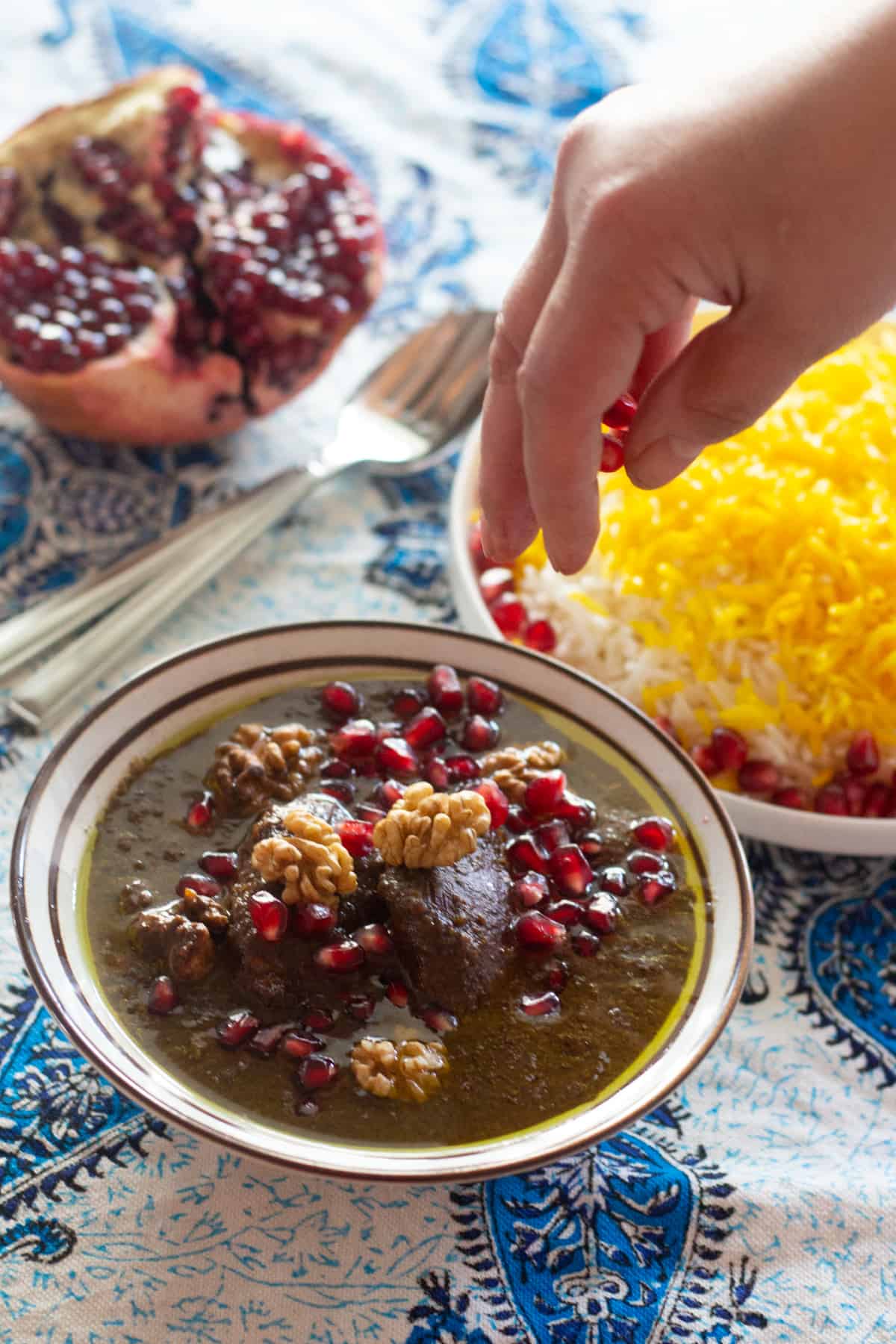
Tips To Make The Best Fesenjan
- Use quality pomegranate molasses: Make sure the pomegranate molasses you’re using doesn’t contain added sugar. The recipe is calling for 1 1/2 cup pomegranate molasses but different brands have different levels of sourness. Start with one cup and if you think your fesenjan is not sour enough, add more pomegranate molasses.
- Mashed pumpkin is optional: Using mashed pumpkin or butternut squash is optional in many recipes. After years or making fesenjan, I’ve come to the conclusion that adding pumpkin to this recipe makes it creamier, thicker and more balanced.
- Don’t use too much oil: Not much oil is needed for this fesenjan recipe as the walnuts will release their fat once they’re heated.
- Use skinless chicken: You can make fesenjan with chicken breast or drumsticks as well as thighs. All pieces should be skin off and preferably bone in for more flavor.
How To Serve Fesenjan
Like many other Persian stews, we serve fesenjan with Persian rice and tahdig. You can also serve it with saffron rice or one pot rice with golden crust. It’s common to serve a Persian meal with a side of salad shirazi, plain yogurt, sabzi khordan (herb platter) or yogurt and cucumber (mast o khiar).
Turn this into a Persian feast with Persian appetizer platter and some Persian love cake and tea for dessert!
Variations Of Fesenjan
This Persian pomegranate walnuts stew can also be made with different proteins. In the north of Iran, people traditionally make this recipe with duck. However, since duck is not widely available, nowadays fesenjoon is mainly made with chicken.
Some families make fesenjan with meatballs. To do so, sear meatballs separately and add them to the sauce n the last 10-15 minutes for them to cook completely.
If you prefer to make it vegetarian, just go ahead and leave out the meat. The secret and beauty of this dish is only in the sauce. As long as you have fesenjan sauce right, you’re all good to go! But if you would like to add a vegetarian protein to it, tofu would be a practical choice.
Storing The Leftovers And Reheating
Store the leftovers in an airtight container and refrigerate for up to 4 days. This stew usually tastes better the next day!
This Persian chicken stew also freezes very well. Let it cool completely and then store in a freezer-safe container and freeze for up to 2 months. To serve, let it thaw in the fridge overnight.
To reheat fesenjan, place it in in a small pot and turn the heat on to medium low. Stir occasionally so it doesn’t stick to the pot. It takes about 20 minutes to reheat completely.
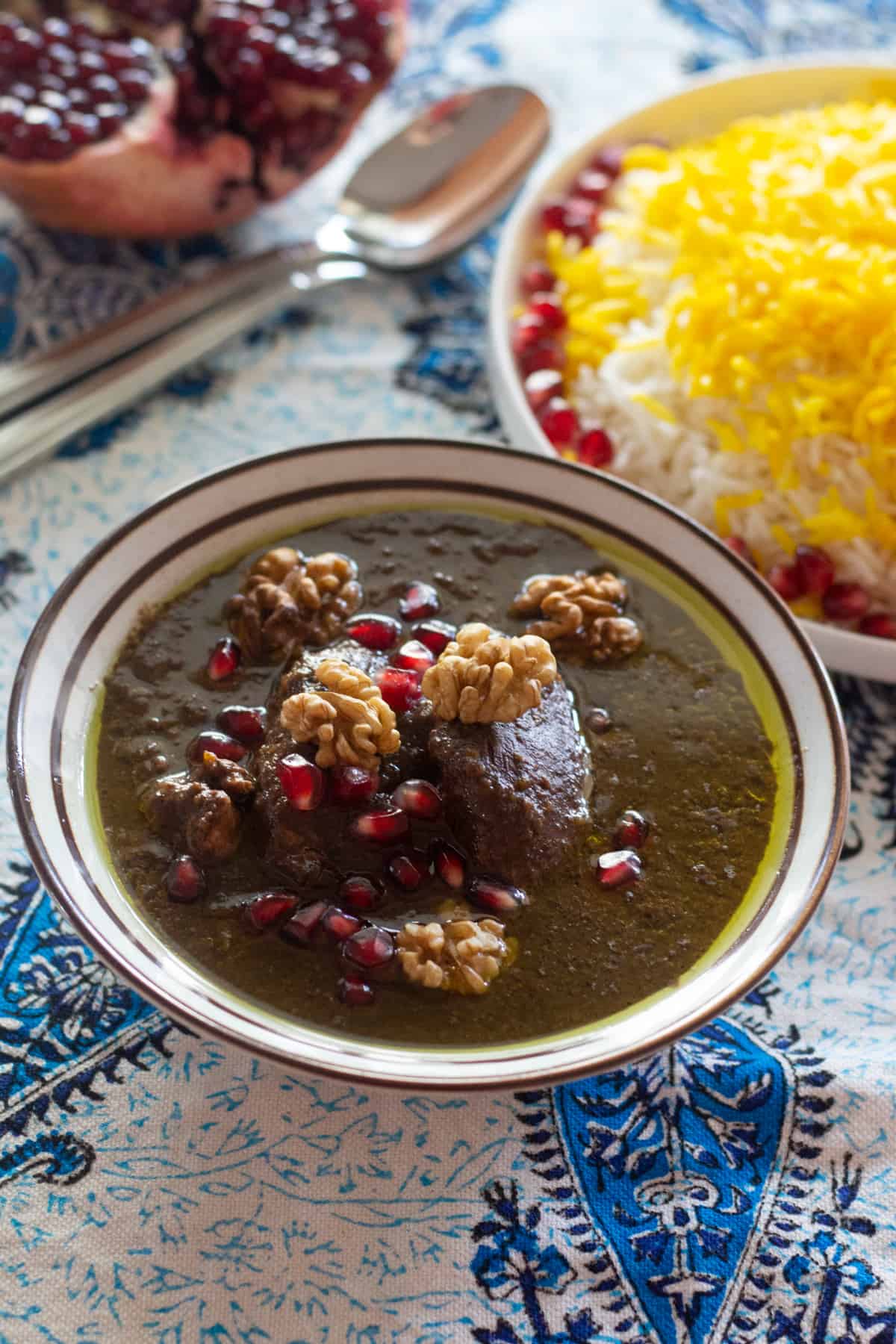
Frequently asked questions
Absolutely. The beauty of Persian stews is that they taste a lot better the next day. You can make fesenjan up to a day in advance and reheat it when you’re ready to serve. It’s also possible to make the sauce up to 4 days in advance and then add and cook the seared chicken an hour and a half before serving.
Pomegranate molasses is basically reduced pomegranate juice. If you would like to make it at home, pour 16 oz pomegranate juice into a pot and bring it boil, then lower the heat and simmer for 45 minutes to an hour until reduced and thickened. After making the recipe, you can refrigerate the leftovers.
Theoretically, yes. Walnuts are the base of khoresht fesejan but if you don’t want to use all walnuts, it’s possible to use 1/3 lb almond meal and 2/3 lb ground walnuts. The process of making the recipe stays as it is. If you prefer to use whole almonds and ground them with the walnuts, make sure to use blanch almonds in order to have them mix with walnuts perfectly.
More Persian Recipes
Persian Recipes
Ghormeh Sabzi – Persian Herb Stew (Video)
Persian Recipes
Salad Shirazi (Persian Cucumber Tomato Salad)
Persian Recipes
Joojeh Kabab (Persian Saffron Chicken Kebab)
Persian Recipes
Ash Reshteh (Persian Noodle Soup)
Did you make this recipe? I’d love to hear about it! Please comment and leave a 5-star🌟 rating below. You can also follow us on Instagram, Facebook, Pinterest or subscribe to our newsletter to get a free e-Cookbook!
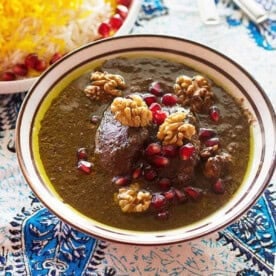
Fesenjan (Persian Pomegranate and Walnut Stew)
Ingredients
- 4 tbsp olive oil
- 8 pieces skinless bone-in chicken thighs
- 1/2 tsp turmeric
- 1 onion, diced
- 1 lb walnuts, About 4 cups
- 1 can pumpkin , 15 oz.
- 1 1/2 tsp salt
- 1/4 tsp black pepper
- 1 1/2 cup pomegranate molasses
Instructions
- Using a food processor, crush the walnuts to form fine crumbs. Make sure not to overprocess, you don't want the walnuts to release their oil.
- Heat 2 tablespoons of olive oil in a pot over medium high heat. Season the chicken with the turmeric, 1 teaspoon kosher salt and 1/2 teaspoon black pepper.
- Sear the chicken for 5 minutes on each side. Remove the chicken and set it aside.
- Heat the remaining olive oil in the pot and saute the onion until golden.
- Add the walnuts and sauté for 5-10 minutes so they start releasing their aroma.
- Add 6 cups of water. Turn the heat up to medium high and bring the mixture to boil, turn the heat down to medium and let it simmer for 1 hour, stirring occasionally.
- Add the pumpkin, pomegranate molasses, salt and pepper and let it cook for 1 more hour.
- Add the chicken back to the pot and simmer for another 30 minutes or until the chicken is fully cooked and the sauce has thickened.
- Taste the stew and add more salt if needed, if it's not sour enough, add some more pomegranate molasses and if it's too sour, add 1-2 tbsp brown sugar.
Video
Notes
- Khoresht Fesenjan is supposed to be thick, not much water is needed.
- You can use canned pumpkin or cooked butternut squash in this recipe. Adding the pumpkin will balance the natural warmth of the dish and also the flavor.
- Some suggest adding bloomed saffron to this dish, I don’t find it necessary since the pomegranate and walnut both have rich flavors.
- Store the leftovers in an airtight container and refrigerate for up to 4 days. You can also freeze this pomegranate walnut stew in a freezer-safe container for up to 2 months. To serve, let it thaw completely and then reheat it in a pot over medium heat.
Nutrition
Nutrition information is automatically calculated, so should only be used as an approximation.
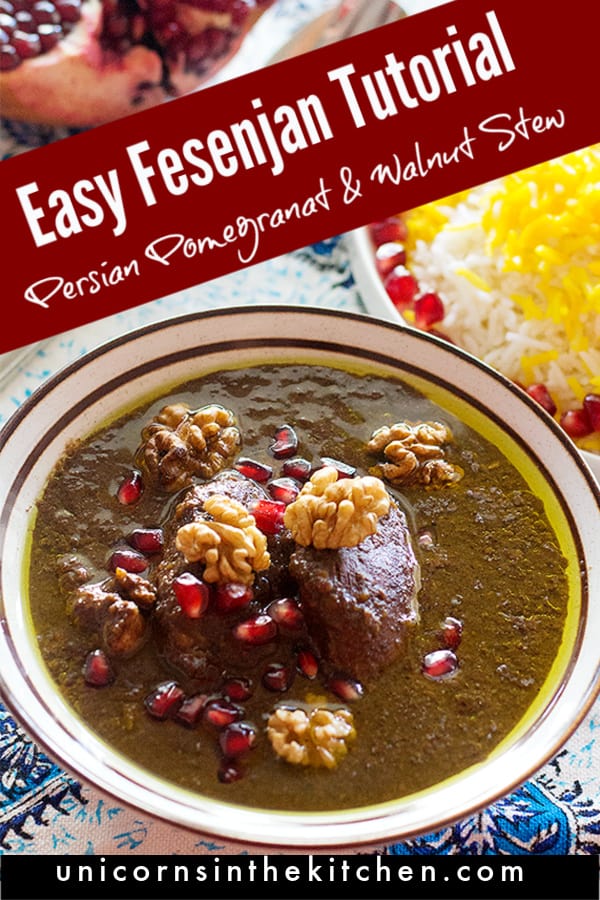
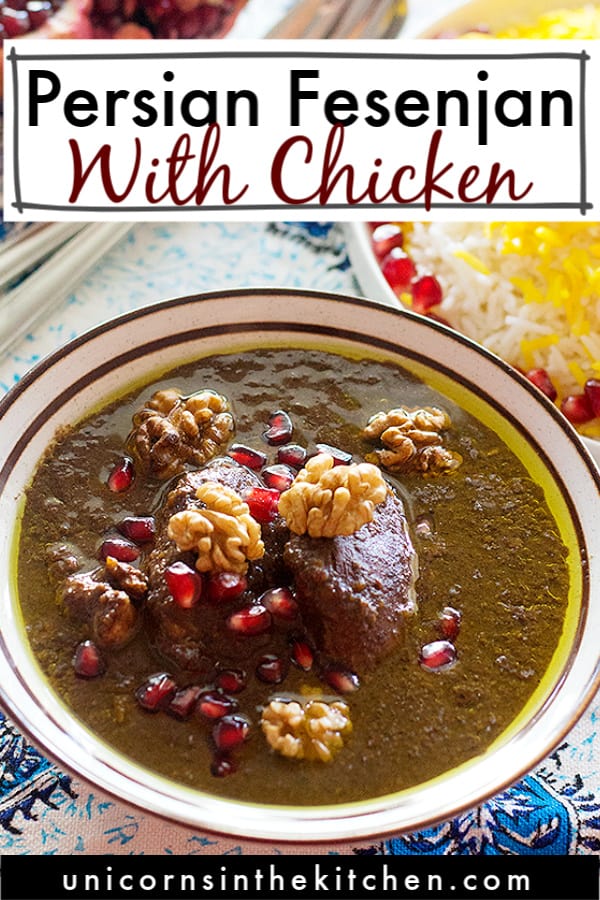
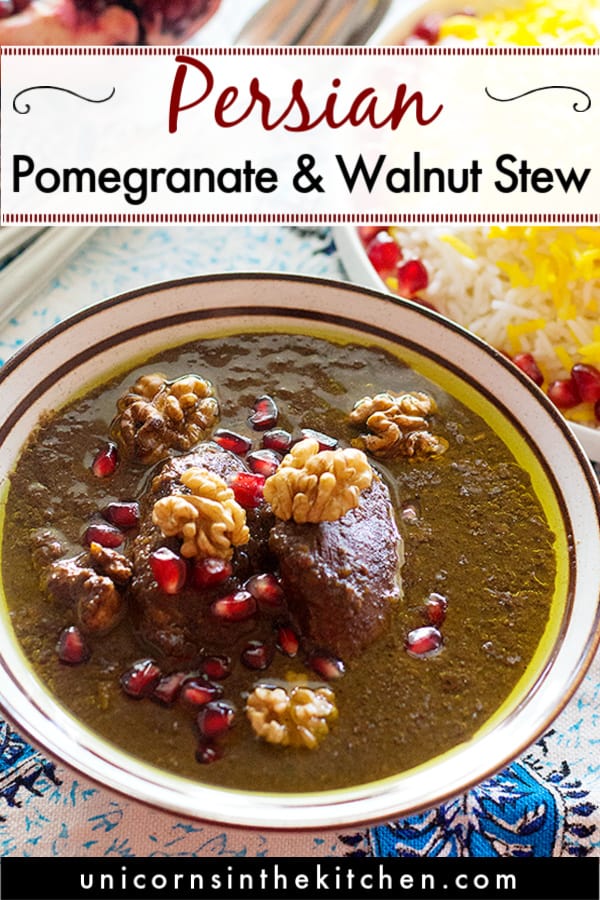
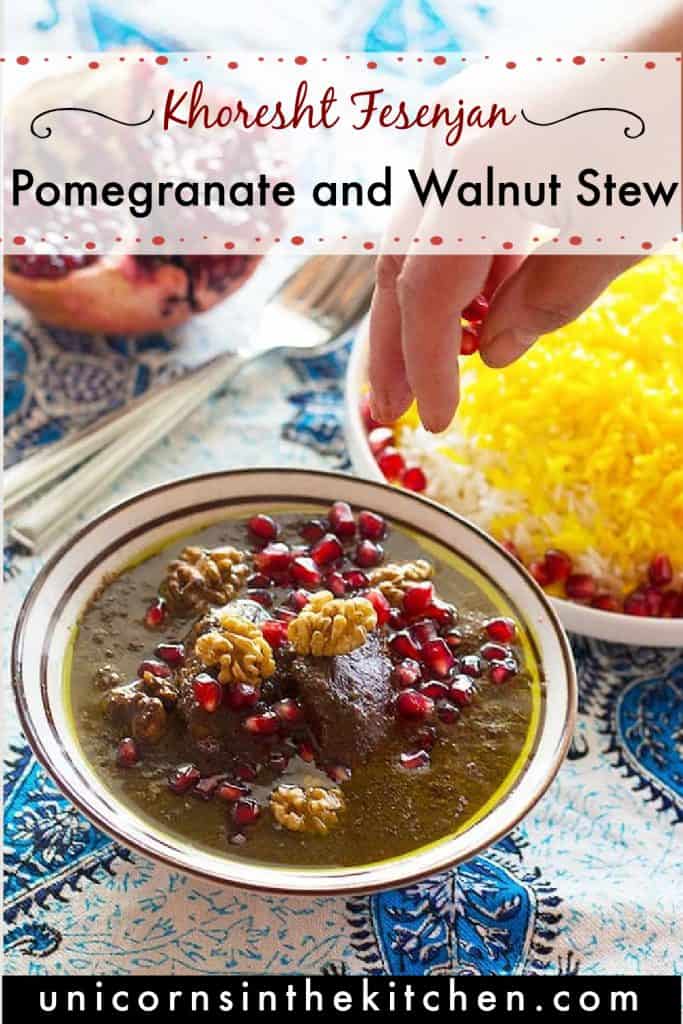


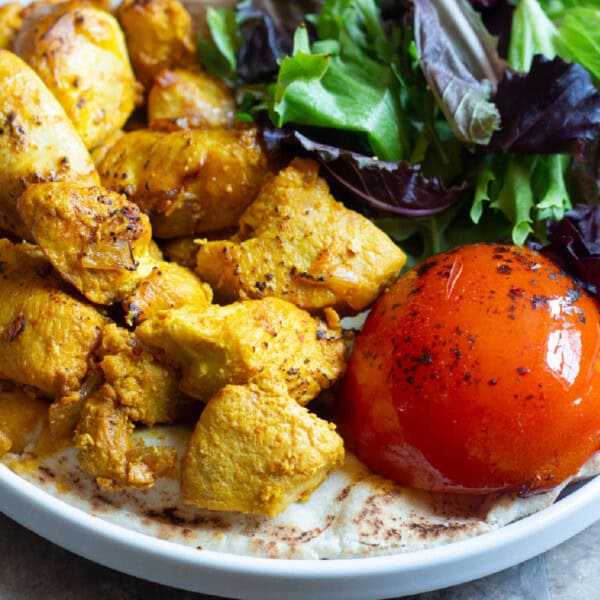
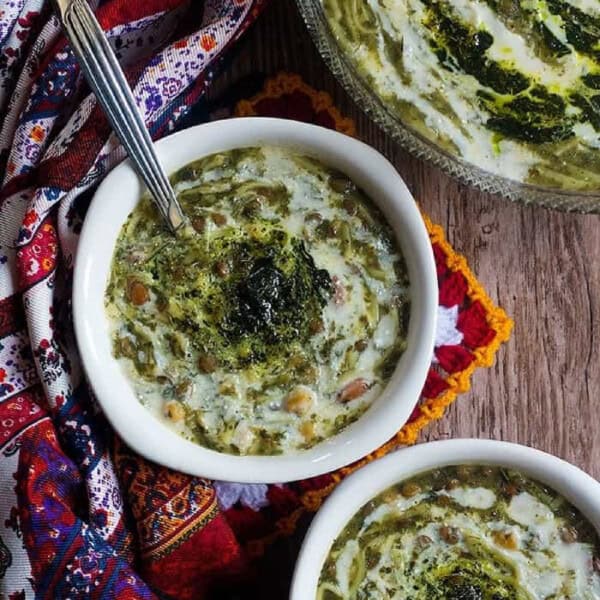









I love fesenjan. I could only have tiny tastes of it in Iran because of the walnuts. When I came back to the States I experimented and learned to make it with PECANS! Pls tell people they can use pecans instead of walnuts. I usually make it during the holidays, so we’re starting to keep an eye out for duck. I try to make Javaher polo for Turkey day. Thanks for all the recipes!
Thank you Susan! Yes, pecans work very well!
CAN I USE BONELESS CHICKEN THIGHS AS NON PERSIANS FIND IT DIFFICULT TO EAT WITH BONES !
Absolutely!